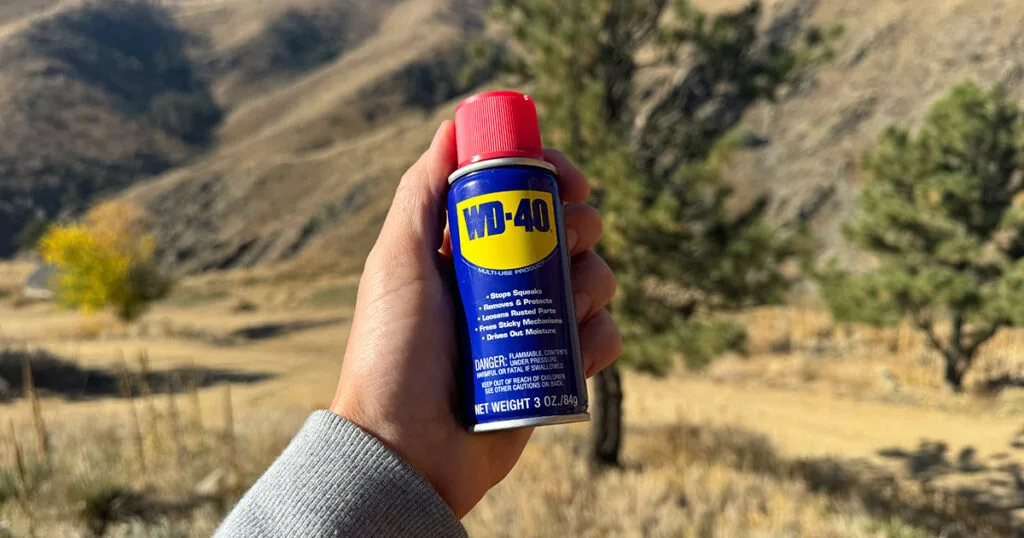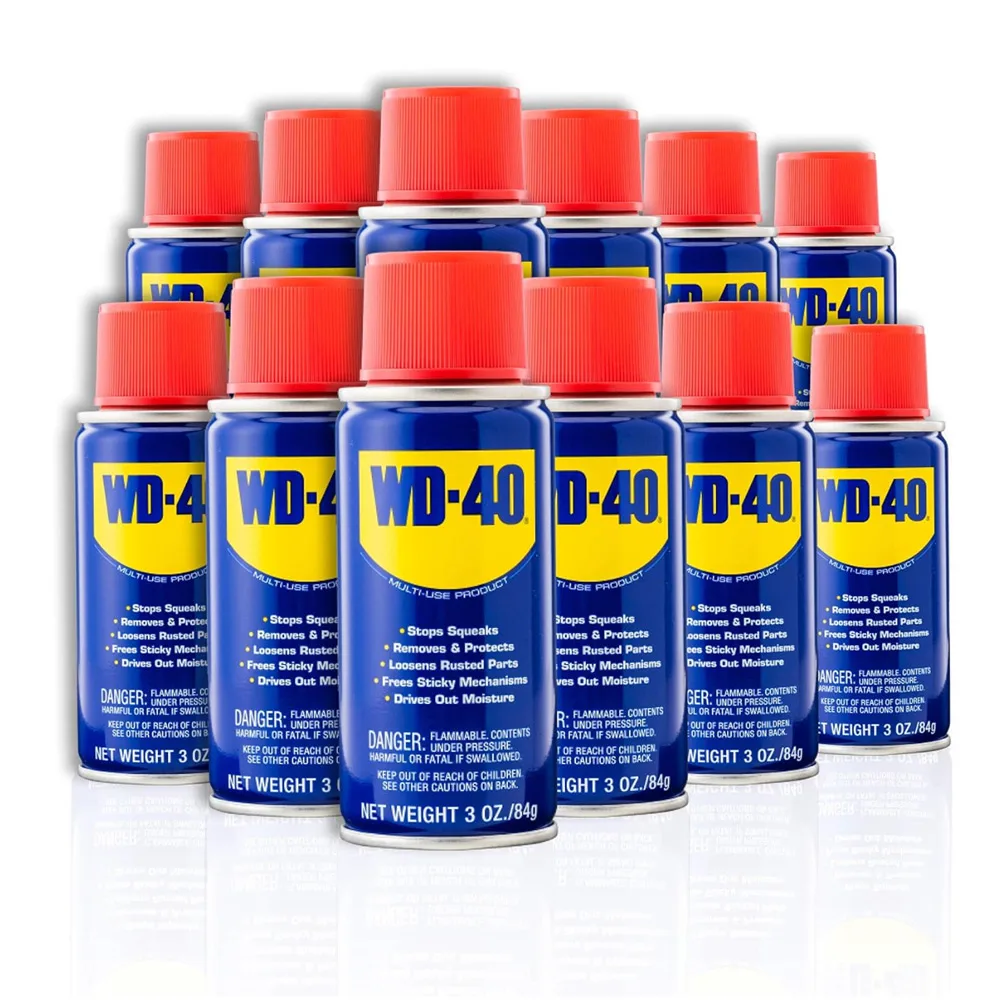In the realm of survival and emergency preparedness, we know just how important stocking the right gear and food can be. And lurking in the shadows of these essentials is: WD-40. This unassuming blue and yellow can might be more associated with garage tinkering than wilderness survival, but its versatility makes it a crucial addition to any prepardness stockpile.

From waterproofing gear and starting fires to preventing rust on tools and even fishing, WD-40’s myriad uses can prove invaluable when you’re up against the elements or in unexpected situations. Don’t be caught unprepared; discover the power of WD-40 in nearly every scenario!
WD-40 General Uses
- Loosening Rusty Parts: Frees up rusted screws, bolts, and nuts.
- Displacing Moisture: Drives out moisture from electrical systems to restore shorted-out connections.
- Cleaning: Removes grease, grime, and other residues from various surfaces.
- Lubrication: Reduces friction on moving parts like hinges, locks, and wheels.
- Protection: Prevents rust and corrosion on metal surfaces.
- Removing Stickers: Helps in peeling off stickers, labels, tape, and excess adhesive.
- Silencing Squeaks: Quiets noisy hinges, wheels, and moving parts.
- Cleaning Tools: Removes paint, grease, and dirt from hand and power tools.
- Preventing Snow Build-up: Spraying on shovels or snow blowers to prevent snow from sticking.
- Cleaning Crayon Marks: Removes crayon from walls and other surfaces.
- Unsticking Zippers: Helps zippers glide more smoothly.
- Removing Gum: Helps in removing gum from shoes, carpets, and hair.
- Cleaning Toilet Bowls: Helps remove lime stains.
- Separating Stuck Glassware: Frees up glass dishes and cups that are stuck together.
- Protecting Silver: Keeps silver from tarnishing.
- Cleaning Grill Grates: Helps in breaking down and removing gunk from grills.
- Preventing Rust: Spray on garden tools, metal fixtures, and other items to prevent rust.
- Removing Coffee & Ink Stains: Helps in lifting stains from fabric and clothing.
- Cleaning Guitar Strings: Removes dirt and extends the life of the strings.
- Lubricating Small Toys: Helps toys with moving parts function better.
- Removing Lipstick: Helps in lifting lipstick stains.
- Preventing Splinters: Protects wooden handles of tools.
- Cleaning Scissors: Keeps scissors moving smoothly.
- Removing Rings: Helps slide off stuck rings from fingers.
- Cleaning Tar Stains: Removes tar from cars.
- Preventing Mildew: Protects shower curtains and other surfaces.
- Lubricating Tracks: For sliding doors, windows, and drawers.
- Removing Water Spots: From mirrors and glass.
- Cleaning Leather: Removes stains and gives a shine (but always test on a small area first).
- Protecting Ski Equipment: Prevents rust on ski edges and makes it easier to put on ski boots.
- Removing Glue: Helps dissolve some adhesive residues.
- Cleaning Bugs: Removes bugs from car grills and bumpers.
- Lubricating Chains: On bicycles, chainsaws, and other equipment.
- Preventing Mud Sticking: Spray on the underside of lawn mowers or shoes.
- Cleaning Phone Screens: Removes fingerprints and smudges (spray on a cloth first, then wipe).
- Lubricating Wheelchairs: For smoother movement.
- Removing Rust Stains: From fabrics and surfaces.
- Cleaning Stainless Steel: Removes fingerprints and smudges.
- Lubricating Locks: For smoother key insertion and turning.
- Preventing Ice Build-up: On windows and surfaces in winter.
WD-40 Emergency Preparedness Uses
- Fire Starter: Spray WD-40 on kindling or a cotton ball to help ignite a fire more easily in damp conditions.
- Waterproofing: Apply a thin layer on boots, gloves, and other gear to repel water and keep them dry.
- Fishing Aid: Spray on fishing lures to attract fish due to the fish oil in the product.
- Emergency Light: In a pinch, a WD-40-soaked rag wrapped around a stick can act as a torch.
- Tool Maintenance: Prevent your survival tools from rusting in damp conditions by applying a light coat.
- Insect Repellent: While not as effective as dedicated repellents, it can deter some bugs and pests when applied to clothing.
- Cleaning Water Containers: Remove algae or other residues from water bottles or containers.
- Improving Snow Gear: Spray on sleds or snowshoes to reduce friction and prevent snow buildup.
- Sealing Leaks: Temporarily seal minor leaks in containers or tents.
- Improving Signal Visibility: In daylight, a shiny, WD-40-coated surface can reflect sunlight, making you more visible to rescuers.
- Emergency Saw Lubrication: If using a manual saw or chainsaw, WD-40 can act as a temporary lubricant.
- Protecting Electrical Connections: If you have devices crucial for survival, like radios, WD-40 can displace moisture and ensure connections remain effective.
- Loosening Stuck Containers: Open sealed or rusted-shut containers more easily.
- Cleaning Hands: Remove sap, pitch, or other sticky substances when soap and water aren’t available.
- Preventing Snow Buildup: Spray on the bottom of tents or tarps in winter conditions to prevent snow and ice from sticking.
- Improving Trap Efficiency: If hunting for food, a light coat on snares or traps can prevent them from rusting and reduce scent.
- Protecting Battery Terminals: Prevent corrosion on batteries in devices like flashlights or radios.
- Clearing Ice: Spray on locks or metal surfaces to help melt and clear ice.
- Maintaining Zippers: Ensure that zippers on tents, bags, and clothing function smoothly and don’t get stuck.
- Barrier Against Rodents: Some users claim that spraying WD-40 can deter rodents, which can be useful if food storage is a concern.
Is WD-40 Toxic?
WD-40 is generally safe when used as directed, but like many household products, it can be harmful if misused or if exposure is excessive. Here are some points to consider regarding the potential toxicity of WD-40:
- Inhalation: Breathing in high concentrations of WD-40 spray mist or fumes can be harmful. It can cause nasal and respiratory irritation. In extreme cases, intentional inhalation (sometimes referred to as “huffing”) can lead to serious health consequences, including damage to the lungs and central nervous system.
- Skin Contact: Prolonged or repeated direct contact with WD-40 can lead to skin irritation. It’s a good idea to wash your hands after using it and to avoid prolonged skin contact.
- Eye Contact: WD-40 can cause eye irritation. If it gets into the eyes, it’s essential to rinse them immediately with plenty of water and seek medical attention if irritation persists.
- Ingestion: Swallowing WD-40 can be harmful. It can cause stomach upset and possibly more severe internal issues. If someone ingests WD-40, they should not induce vomiting and should seek medical attention immediately.
- Environmental Concerns: While WD-40 is not highly toxic to the environment, it’s still a good idea to prevent it from entering waterways, as it can harm aquatic life.
- Flammability: WD-40 is flammable. It can ignite if exposed to open flames or sparks. It’s essential to use it in well-ventilated areas and keep it away from sources of ignition.
- Propellant: The propellant used in the aerosol cans can be harmful if inhaled directly.
What’s the Shelf Life of WD-40?
WD-40 does not have a defined expiration date. When stored under normal conditions (i.e., kept out of extreme temperatures and not exposed to direct sunlight), a can of WD-40 can remain effective for many years. However, over time, the propellant in the can may dissipate, which means the product might not spray out as effectively or at all. The liquid product itself, though, remains useful.
To maximize the shelf life of your WD-40:
- Store it in a cool, dry place.
- Keep it away from direct sunlight.
- Ensure the cap is tightly secured to prevent the propellant from escaping.
For long term preparedness, is it better to have a bunch small cans or large cans of WD-40?
When considering long-term preparedness and whether to stock up on small or large cans of WD-40 (or any other product), there are several factors to weigh:
- Shelf Life: As mentioned earlier, the product itself doesn’t degrade significantly over time, but the propellant in the can might dissipate. If you’re thinking in terms of decades, even the propellant in large cans might not last that long.
- Portability: Smaller cans are more portable, making them convenient for on-the-go situations, bug-out bags, or distributing among multiple kits.
- Storage Space: Large cans might be more space-efficient in terms of the volume of product per storage space. However, smaller cans offer flexibility in storage, allowing you to tuck them into various nooks and crannies.
- Usage Rate: If you anticipate using WD-40 frequently and in large amounts, then having a few large cans might be more practical. On the other hand, if you’re thinking of occasional use or for specific emergencies, smaller cans might be better to ensure you always have a can with propellant.
- Risk of Contamination: If a large can gets contaminated (e.g., dirt in the nozzle), you risk losing a more significant amount of the product. With smaller cans, you only risk the amount in that particular can.
- Economic Factors: Sometimes, buying in bulk (larger cans) can be more cost-effective. However, if you’re not going to use all the product, it might be a false economy.
- Redundancy: In survival and preparedness, redundancy can be beneficial. Having multiple small cans means if one fails, gets lost, or is damaged, you have others as backup.

